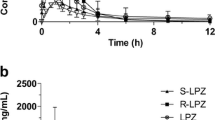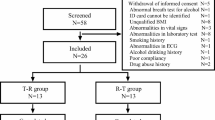Abstract.
Objective: To study the pharmacokinetics of esomeprazole, one of the optical isomers of omeprazole, after 20 mg or 40 mg single and repeated oral and intravenous administration to healthy subjects. The main metabolites of esomeprazole were also assessed after the 40-mg oral dose. Methods: In two separate studies, 16 healthy male subjects and 16 healthy male and female subjects received intravenous doses of 20 mg and 40 mg esomeprazole, respectively, on the first investigation day. After a wash-out period of 5–14 days, the same doses (20 mg as a solution and 40 mg as a capsule) were given orally for 5 days and then again intravenously on day 6. Blood samples for determination of esomeprazole and its metabolites were collected 12 h or 24 h post-dose and were analysed using normal-phase liquid chromatography with ultraviolet (UV) detection. Pharmacokinetic parameters of esomeprazole and its metabolites were estimated using non-compartmental analysis. Geometric means and ratios of the geometric means together with 95% confidence intervals (CI) of the pharmacokinetic parameters were calculated using analysis of variance (ANOVA). Results: Plasma clearance (CL) of esomeprazole decreased from 22 l/h to 16 l/h and from 17 l/h to 9 l/h following repeated dosing of 20 mg and 40 mg, respectively. Total area under the plasma concentration–time curve (AUC) increased (from 1.34 µmol×h/l to 2.55 µmol×h/l) with absolute bioavailability (F) being 50% on day 1 and 68% on day 5 after the 20-mg oral dose. AUC increased (from 4.32 µmol×h/l to 11.21 µmol×h/l) with F being 64% on day 1 and 89% on day 5 after the 40-mg oral dose. The plasma levels for esomeprazole sulphone were substantially higher on day 5 than on day 1, while those for 5-hydroxy esomeprazole were marginally higher on day 5 than on day 1 following repeated oral dosing of 40 mg esomeprazole. No side effects attributable to esomeprazole were noticed. Conclusion: The increased AUC of esomeprazole with repeated dosing is probably due to a combination of a decreased first-pass elimination and a decreased systemic clearance.
Similar content being viewed by others
Author information
Authors and Affiliations
Additional information
Accepted in revised form: 18 August 2000
Electronic Publication
Rights and permissions
About this article
Cite this article
Hassan-Alin, M., Andersonn, T., Bredberg, E. et al. Pharmacokinetics of esomeprazole after oral and intravenous administration of single and repeated doses to healthy subjects. Eur J Clin Pharmacol 56, 665–670 (2000). https://doi.org/10.1007/s002280000206
Received:
Published:
Issue Date:
DOI: https://doi.org/10.1007/s002280000206




